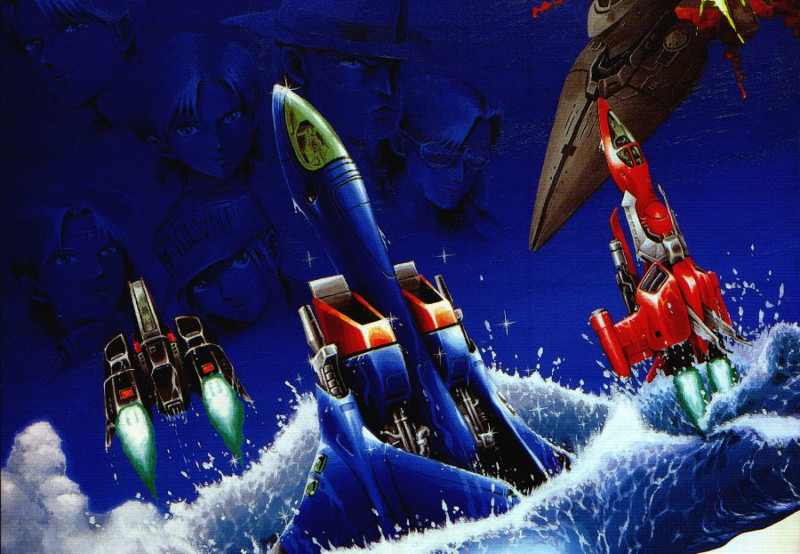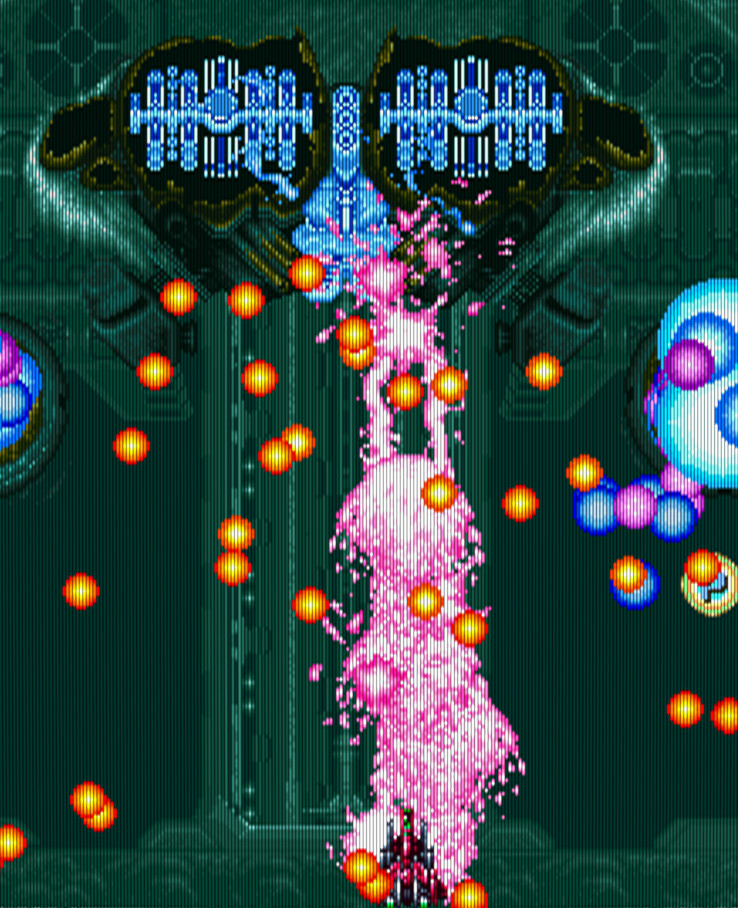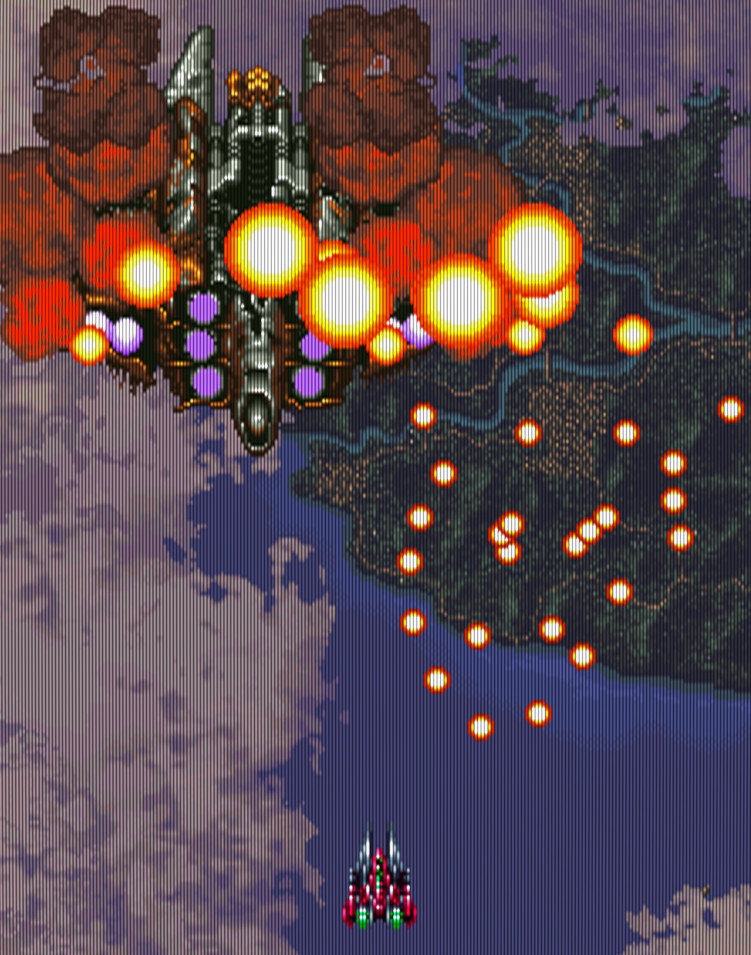
Batsugun (1993, 1994, Toaplan)
Whether in its original or Special version, Batsugun represents an interesting structural detour within the first four Tsuneki Ikeda-led shmups. With his first known entry into the shmup canon, V-V, we see his near-standard 2 medium length loops with his favored revenge bullets mechanic showing up in loop 2, albeit all with checkpoints, and a limited number of extends. With the first two Cave outings DonPachi and DoDonPachi, we see a similar setup sans-checkpoints. If V-V, after Toaplan's traditional line of games that both loop and award extends infinitely, shows an acknowledgement that maybe players shouldn't be able to hog the machine at the game center all day for 100 yen by limiting the number of loops and extends, the original version of Batsugun could perhaps be considered an overcorrection. Checkpoints are gone and you instead respawn instantly on death, you get 1 extend for a total maximum of 4 lives for a credit, and the final boss is over and done with about 15 minutes after you start. There are no loops and the game is over after just 5 fairly brief stages.
Another feature that DonPachi would subsequently walk back is the absolutely blistering pace; the stages and game overall may be short, but they're packed. Toaplan shmups are typically quite deliberate, with lots of spaced out zako fights (In Tatsujin Ou we see probably the most extreme example of this style), but in Batsugun the dead space is shortened significantly and the enemy patterns are perhaps a tad less repetitive than usual. With the pace and the short length of the game, the original version of Batsugun is a rambunctious burst of action that, while lots of fun and never boring, doesn't feel quite as substantial and epic as previous Toaplan outings in terms of raw level design. An additional stage would have done a lot to round it out, but even just a second loop suffices to provide more longevity. Unless you want to learn its wacked out scoring tricks ("trick" really) then there's not a whole lot to do once you've no-missed the game, which, while far from trivial, is still a fair bit easier than even just a basic one loop clear of many of Toaplan's previous shmups. In the end I can't consider a game's being exciting but short too much of a knock against it; I reckon a tight, fun-as-hell 15 minutes beats an additional 15 minutes of boring filler.
Batsugun Special appends loops in a rather strange fashion: loop 2 omits stage 1, loop 3 omits stages 1 and 2, and loop 4 omits stages 1-3 before the game ends (in other words, the last loop is just two stages), and you get an interesting progression of revenge bullet types for each one. This would seem to provide the substance that its predecessor was only sorta lacking, and with the additional game length also comes new mechanics: a shield, replenishable over time, that allows you to sustain a hit without dying, a more powerful bomb that now fills the screen when detonated, a smaller player hitbox, and a first loop with slower bullets. A 1-ALL in this game is often recommended to those new to shmups for the fact that it's pretty easy, and I would go so far as to say a 2-ALL is roughly equivalent in difficulty to a 1CC of the original game (however you would ascertain that; a subject for a future essay maybe). This has the unfortunate effect of making the first loop a bit of a slog after a while, and even faster if you're already well acquainted with the original game. The hitbox being smaller was likely to accomodate the revenge bullets for later loops and I don't have much reason to bemoan the improved bomb, but the shield seems egregious and the original game, being fairly well balanced, could have easily slotted in for this game's first loop without the bullet speed reduction.

Anyways structural and balance nitpicks aside, damn, the music rules! Fuck, I don't know what Yoshitatsu Sakai went on to do after this, if anything, but he killed it here. It's bright and poppy like Tatsujin Ou and sometimes has kind of a metal edge to it, and it really drives the action forward in a way very complimentary to the aformentioned quick pace. You even get individual boss BGMs! What other arcade game does this?! And they're all great! Music in a shmup is extremely important; this can't be overstated. In an autoscroller by definition you don't get much time to wait around and consider your options, so in this sense good BGM has to compliment whatever is going on, even sync right up to it at times. It makes no sense to me when people play their own music over shmups as even if you've put 1,000 hours into the game you're playing the music still provides valuable audio cues, and the music should still be good, Hell. I still listen to albums I've heard a billion times, and if the music of the game you're playing isn't good then why the hell are you even playing it for this long? This is why I couldn't stick with Thunder Dragon 2, cuz even if I like the two songs it has, it's still two songs over like 8 stages and boss encounters, and fuck that. Anyway, do NOT do this game a disservice by subtracting its audio, it's a big element of what makes it great.
The visual design is similarly vivid, upbeat and varied. You get three ships to choose from with a different color each for the 1p and 2p sides, and each of these six combinations gets a unique pilot with their own names, attractively drawn and animated portraits, end-of-stage win quotes and even endings. It utilizes a bright color palette throughout that actually differs between the original game and Special, and the environments lend themselves to this; you got beaches, mountains, skies and clouds, and so on. The sprite art continues in the high standard set by Tatsujin Ou, thru Dogyuun and V-V. Not to mention the wide, colorful variety of bullet types, which erupt in large numbers and pretty patterns. Speaking of which, let's address the age old question: Is Batsugun a bullet hell? Is it the first bullet hell? Well, without any further context or criteria to accompany the question, it is as you like, but that's obviously not a satisfying answer.
We can approach these questions in a number of ways by establishing some objective criteria. We could ask, for example, what game was the term "danmaku" coined for, i.e. we could go about this historically. Unfortunately I don't know Japanese and therefore am a bit limited in terms of the research I can do, but Japanese Wikipedia and its associated source seem confident in stating that DoDonPachi was the first danmaku; whether or not this actually means this is how the term in reference to shmups was coined I don't know, but nonetheless this is a line of inquiry we could pursue and maybe even fulfill. As silly as it may be, we could also establish a minimum bullet count for a kind of danmaku "standard", e.g. if a shmup ever has more than 50 bullets on screen then it's a danmaku, and maybe we could include a standard for the speed of the bullets in pixels per second or something like that. This of course would not be any kind of useful definition as it doesn't really describe how the term is used, so along that line, how is it used? Well, it generally refers to a game that covers the screen in lots of slow moving bullets, often in patterns rather than aimed. There is no harder criteria here because thus far none has been needed, and if we go by a lot of the discussions I've seen about it online over the years, the usual attitude is that DoDonPachi is unquestionably a bullet hell, whereas its progenitors Battle Garegga, DonPachi, and Batsugun get varying degrees of "eh, kind of." Even in Tatsujin Ou and V-V we see larger quantities of slower moving bullets than their predecessors. As-is, it's not a technical term with definite rules governing its proper usage; someone just saw DoDonPachi probably and was like "wow that game's throwing curtains of bullets at you!" and it caught on. Given the indistinctness of the term, the answers one might give to the question "is Batsugun a danmaku" will likely be similarly indistinct.

Every Toaplan shmup previous to this one that featured a variety of weaponry would include them in the form of item pickups, meaning you would blow up item carrier enemies that appear periodically throughout stages and they would sometimes drop an item that swaps your main weapon to something else. In Tatsujin, this was balanced quite well as you had significant occasion to use all three weapons, but in most other games one weapon is clearly the best to use in nearly all situations, and some weapons would spell a death sentence if accidentally picked up (anyone who's played Same! Same! Same! knows that the green weapon drop is almost always just as deadly as any bullet). Ikeda's shmups would progressively streamline the Toaplan formula in many ways over the years, and Batsugun was the first to turn the mechanic of having one ship and multiple weapon types into having multiple ship types each with their own exclusive weaponry. Here the developer loses the ability to tailor the level design around having a specific weapon for a specific part, but clearly no one was following that most of the time anyway, so it makes sense to have three reasonably well-designed shot types that you can pick and keep for the whole game, and just leave it up to the player's preference as to which is the most useful. Unfortunately it takes until DonPachi, this game's successor, for the concept to really shine through, as here there's not a lot of reason to use any ship besides Type-B (piloted by either Beltiana or Alteeno, though there's no difference between the two mechanically), because while its shot starts out narrow, when fully leveled up it gains a secondary homing shot, whose addition makes the ship's overall loadout even more potent than either of the other types' wide shots, and with a decent ship speed to boot. The fact remains however, there is absolutely NO annoying powerup dodging in this game, so it's an absolute win overall.
As far as scoring goes, there's not much to say. Excess powerup items will increase in value as you pick them up, and you can reveal little pigs in the ground that grant lots of tick points just by hovering beside them. There's no overall system to speak of, and there's little tricks here and there, but the vast majority of your score comes from one boss milking trick in stage 4 (that you of course have to perform four times in Special, which can be counterstopped). It's not terribly interesting and is nothing like the typically convoluted but at least smoothly integrated and less arbitrary scoring systems of Ikeda's later games.
This game represents a streamlining of many of the crustier aspects of older Toaplan shmups. In terms of powering up your ship, level design and pacing, overall structure and progression, and bullet count to hitbox ratio, Batsugun picks up right where V-V left off in filing off vestigial mechanics for a more player-friendly experience. As mentioned earlier, DonPachi would adjust some of these changes, for better and worse, and the manner of streamlining isn't always ideal, but surely in Batsugun lies the attitude that would drive all of Cave's output: that the essential joy of the STG is shooting enemies and dodging bullets. In this sense, Batsugun is a stellar representative of the essence of a shooting game.
Final rating: 5/5 (Great)